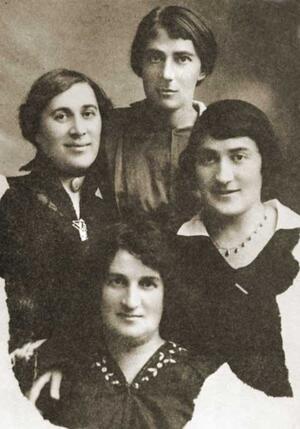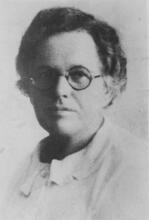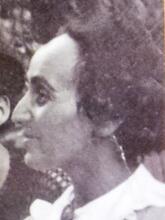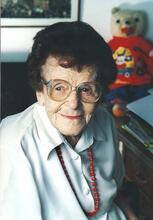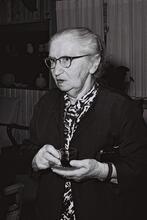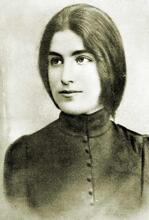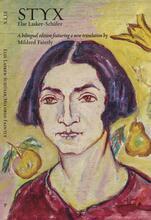Rahel Bluwstein
Rahel Bluwstein was born in Russia in 1890 and moved to Palestine in 1909, where she became the first student on Hannah Meisel’s training farm for young women at Kevuzat Kinneret. Rahel spent two years at Kevuzat Kinneret until, in 1913, at Meisel’s insistence, she was sent to France to continue her agronomy studies. With World War I leaving her stranded in Europe, she moved to Odessa and worked at a children’s refugee home, where she contracted tuberculosis. In 1919, she returned to Palestine and settled at Kevuzat Deganyah as an agronomist until she was forced to leave due to her illness. In 1925 Rahel moved to Tel Aviv, reaching the peak of her poetic output until her death from tuberculosis in 1931 at the age of 41.
Rahel’s Literary Legacy
Rahel Bluwstein is rightfully considered the “founding mother” of modern Hebrew poetry by women. In the thousands of years that elapsed between the poetry of Deborah the Prophet and the early twentieth century, virtually no Hebrew poetry was composed by women. During the renaissance and flowering of modern Hebrew poetry, which produced such poets as Bialik and Tchernichowsky, there were no women poets. It was only in the 1920s that women began to write serious poetry, with intellectual intent, in Hebrew. Rahel, along with the other women poets who began to write and publish at this time—Esther Raab, Yokheved Bat-Miriam, and Elisheva—initiated a trend that introduced new stylistic, linguistic and figurative possibilities into Hebrew poetry.
Of the four pioneering women poets, Rahel was the most admired, although her success came only late in life and, even more so, after her death. During her lifetime, she enjoyed some recognition, but this did not presage the extent of her future popularity. Rahel’s writing had an obvious impact on future generations of men and women poets. More than twenty different editions of her collected poetry and other writings have been published since her death, and a new edition of her poetry joins the library of Hebrew literature every few years. Many of her poems, among them “Zemer Nogah,” “Gan Na’ul” and “Kinneret,” have been set to music and have become an integral part of Hebrew culture. Thanks to them, Rahel has achieved the status of an eminent, beloved national poet.
Early Life and Family
Rahel was born on September 29, 1890 to Isser Bluwstein (1841?–1923), a merchant and businessman whose wealth came from diamond and real-estate transactions, and Sofia Mandelshtam. Sent at an early age to serve in the army of Tsar Nicholas, Isser was careful to maintain his religious observance throughout his long years of service. When he was released twenty-five years later, he settled in Vyatka, on the Siberian border. Bluwstein married a woman who gave birth to four children and died young.
Sofia, Rahel’s mother, was Isser’s second wife. She was an educated woman who was fluent in several languages and corresponded with contemporary intellectuals and thinkers, among them the writer Leo Tolstoy. Sofia’s father was the rabbi of Riga’s Jewish community, and later, of the Kyiv community. Her brother, Max Mandelshtam, who ran a hospital in Kyiv, was president of the Fifth Zionist Congress (Basle, 1901). Sofia raised Isser’s children from his first marriage and bore eight children of her own, including three daughters: Shoshana (1889–1965), who was one year older than Rahel and moved together with her to pre-state Palestine; Rahel; and Batsheva, born to Sofia late in life, who became a talented pianist and later immigrated to Palestine in her sisters’ footsteps.
Following the marriage of Isser and Sofia, the Bluwstein family moved around Russia, eventually settling in the city of Poltava, Ukraine, where Rahel spent her childhood and early youth. The family maintained a traditional Jewish, yet educated, lifestyle. The daughters were fortunate enough to receive a weekly lesson in Hebrew; although they did not actually master the tongue, they were able to learn the language of prayer.
Establishment and Life in Palestine
Sofia Mandelshtam, who was adored by her children, died in 1906, when Rahel was sixteen. Isser, who was already sixty-five at the time, soon took a third wife, a woman named Masha Naumova, whom Rahel despised. Shortly thereafter, Shoshana and Rahel moved to Kyiv, where they lived with their older sister, Liza. In 1909 they relocated from Kiev to Odessa. It had been Rahel’s childhood dream to be a painter and in Odessa she registered for several art courses. During their stay in Odessa, the Bluwstein sisters became friendly with other young Jewish people, with whom they set sail to Palestine for a short visit. They had planned on continuing from there to Europe to progress in their studies, but they were immediately captivated by the Land of Israel and resolved to remain there.
In order to learn Hebrew thoroughly, Shoshana and Rahel decided to forbid themselves to use Russian. They took a vow of silence until they had learned the local language and allowed themselves only one hour a day of Russian in order to attend to everyday affairs. In the moshava of Rehovot, where they were taken in upon their arrival in Palestine, the two sisters regularly visited a kindergarten in order to learn Hebrew from the children. They were joined shortly afterward by their younger sister, Batsheva, and the home of the three Bluwstein sisters became a well-known gathering place for parties, dancing and singalongs.
In 1911, after a year in Rehovot, Rahel sought work in agriculture, becoming the first student at the training farm for young women set up by Hannah Maisel at Kevuzat Kinneret. She stayed there for two years and in 1913 was sent, at her teacher’s insistence, to continue her studies in agronomy in Toulouse, France, so as to contribute her knowledge to the bolstering of Jewish agriculture on the moshavot and early A voluntary collective community, mainly agricultural, in which there is no private wealth and which is responsible for all the needs of its members and their families.kibbutzim. In Toulouse, Rahel was the only woman and only Jew among her fellow students, until the arrival of Rahel Yanait Ben-Zvi. In 1914, with the outbreak of World War I, contact between Ottoman Palestine and France was severed and Rahel had difficulty financing the remainder of her stay there. Nevertheless, she completed her studies, later journeying to Russia where she lived with relatives. While in Russia, she translated Hebrew poetry by Bialik and Fichman for Jewish periodicals published in Russian. At a certain point, she was also employed as a childcare worker, taking care of refugee children from Odessa. (It was here that she apparently contracted tuberculosis, from which she died some fifteen years later, in 1931.) Between 1915 and 1918, while living in France and Russia, Rahel wrote poetry in Russian. In these works one can discern her first tentative forays into a poetic of her own, which later came to fruition in her Hebrew poetry.
Return to Palestine After World War I
In 1919, with the end of World War I and the renewal of contact between Europe and Palestine, Rahel set sail on the Russland, considered the first ship to carry the immigrants of the Third Lit. "ascent." A "calling up" to the Torah during its reading in the synagogue.aliyah (1919–1923) to Palestine. Her father, Isser, now over eighty, also came to Palestine during this period and settled in Tel Aviv with his third wife. Rahel joined Kevuzat Deganyah as an expert agronomist, but her illness compelled her to cease engaging in physical labor. It was during her time at Deganyah that her first Hebrew poem, “Halokh Nefesh,” was published, in the prestigious Hebrew literary journal Ha-Shiloah (volume 37, 1920). The first Hebrew poem written by a woman to be published in the journal since its founding, this was in fact the first poem by a professed woman poet in modern Hebrew poetry.
During her years at Deganyah, Rahel also wrote several humorous poems that appeared in the A voluntary collective community, mainly agricultural, in which there is no private wealth and which is responsible for all the needs of its members and their families.kibbutz leaflet “Dagdeganiton.” A Holiday held on the 14th day of the Hebrew month of Adar (on the 15th day in Jerusalem) to commemorate the deliverance of the Jewish people in the Persian empire from a plot to eradicate them.Purim skit entitled “Sipuk Nafshi,” also written by her and published in the “Dagdeganiton” of Purim 1921, was recently discovered. “Sipuk Nafshi” is noteworthy for its ironic tone, which is not typical of her writing. Rahel’s satiric jibes, which are not without bitterness, are directed first and foremost at phrases from the pioneer lexicon—among them the sipuk nafshi (emotional satisfaction) of the title—along with such values as “the collective” and equality. Rahel was aware of the gap between the slogans of equality proclaimed by the spokesmen of the pioneer movement and the day-to-day routine of the women on the kibbutzim, and gave them good-natured expression in this short play.
Later Years and Death
Due to physical difficulties stemming from her illness, Rahel was sent to work in the children’s nursery; but when she was definitively diagnosed with severe tuberculosis, she was forced to leave Deganyah and seek a different home. She moved to Petah Tikvah, where she taught agronomy at a school for girls. She later moved to Jerusalem, where she taught farming as well as Hebrew and French. She resided in Jerusalem for four years, during which she drifted between various apartments owned by friends. She was later hospitalized in Safed for treatment of her illness. Upon her release from the hospital in 1925, she moved to Tel Aviv. At first she lived in the home of her brother, Yaakov Bluwstein-Sela, an expert in linguistics who was fluent in sixteen languages and personally financed the founding of the Beit Ha-Am community center in Tel Aviv, where he frequently lectured on cultural topics. Rahel was close to her brother, but poor relations with his wife, and concern for the health of their young daughter, Aviva, spurred her to look for a separate residence. With the help of a friend, Dr. Moshe Beilinson, she rented a one-room flat at No. 5 Bograshov Street, where she lived out the rest of her days. This flat was described in several of her poems.
The years between 1925 and 1931 were the most fruitful in terms of Rahel’s poetic output. Due to her physical condition, she could not work for a living and depended on a small annuity left her by her father upon his death in 1923 and on the royalties she received for the publication of her poems in the Hebrew press. She wrote poems and critical reviews and published her poetry in the Davar newspaper, which became her intellectual home upon its founding in 1925. Rahel’s first book of poetry, Sapiah, was brought out in 1927 by the Davar publishing house. Her second book, Mi-Neged, was published in 1930. That same year, her children’s book Ba-Bayit u-va-Hutz came out, with rhymes written by Rahel accompanying colorful drawings of animals. The existence of the book, which was printed in a limited edition by toy seller Reuven Goldberg, was totally forgotten, and it was rediscovered only in the 1970s.
In early April 1931 Rahel’s condition deteriorated and she was sent by friends to a sanatorium for pulmonary diseases in Gederah. Her condition did not improve, and she asked to return to Tel Aviv to die there. On April 15 she was transferred by horse-drawn carriage from Safed to Hadassah Hospital in Tel Aviv. One day later, on April 16, 1931, Rahel died, aged only forty-one. The following day, her funeral procession set out from the home of the Histadrut Executive (Beit Va’ad ha-Po’el) to Beit Davar, where the eulogies were delivered. Afterwards, the mourners traveled to the cemetery in Kevuzat Kinneret. In one of her poems Rahel had expressed a desire to be buried there, and her friends treated this as a last will and testament. Her third book of poetry, Nevo, which she compiled during the final year of her life, was published posthumously by Davar, in 1932.
Literary Contributions to Modern Hebrew Poetry
Rahel wrote poetry unencumbered by flowery language. She labored to invent new poetical language that was close to the spoken language and free of the residue of the scholarly, textual culture of the heder (European religious schools for young children). Her writings reveal a clear-eyed awareness of the fact that she was operating in a patriarchal cultural space that minimized and excluded women. She often wrote of her longing to be understood, of the feeling of insignificance of a sick woman in a world that revered strength and power, and of the constant tension between the desire to be loved and the fear of the artistically destructive emotional and poetic price of love fulfilled.
In the absence of a Hebrew poetic model, Rahel adopted the Russian poet Anna Akhmatova (1889–1966), turning her into a “poetic mother” of sorts. She even translated a small selection of Akhmatova’s poems into Hebrew. The French poet Francis Jammes (1868–1938) also served as a source of inspiration; Rahel wrote about him and translated a number of his poems. The cultural tendency has been to identify Rahel’s poetry with personal, “feminine” themes such as motherhood, longing and love; but her poems in fact dealt with a much broader range of subjects, treating them in a sophisticated, probing manner.
Rahel’s affiliation with the avant-garde group of Second Aliyah pioneers, her dedication to Zionist ideals and her agonizing death, made her a symbol in the eyes of the Israeli public—and her mythic status persists to this day. But the idealization of her character has come at the expense of her work. Her poems are sung by one and all, but literary criticism and academic research have treated Rahel as a poet of limited abilities and have not accorded her poetry the serious study that it deserves. The pursuit of simplicity that stood at the center of Rahel’s poetic oeuvre was understood by the critics, in particular Bialik, as feminine weakness, allowing them to relate to her as a poet whose works do not demand scrutiny. It is only in recent decades that the academic world has begun to recognize the sources of Rahel’s poetry, with its elements of a relentless quest, and to explore the tension between her simplicity of expression and the meanings conveyed by this simplicity.
Selected Works
Poems, Letters and Reviews
Hebrew
Across From. Tel Aviv: 1930.
Aftergrowth. Tel Aviv: 1927.
Inside and Outside Home: Poems for Children. Merhavyah: 1930 [1974].
Nevo: Final Poems. Tel Aviv: 1932.
Rahel: Poems, Letters, Writings. Edited by Uri Milstein. Tel Aviv: 1994.
The Poems: Sapiah, Mi-Neged, Nevo. Tel Aviv: 2003.
To You and About You: The Love of Rahel and Michael—Letters, Poems, Commentaries. Compiled by Binyamin Hachlili. Tel Aviv: 1987.
Rahel in Translation
The Defiant Muse: Hebrew Feminist Poems from Antiquity to the Present. A Bilingual Anthology. Edited by Shirley Kaufman, Galit Hasan-Rokem, and Tamar S. Hess. New York: 1999.
De loin suivi de Nebo (French). Translated by Bernard Grasset. Arfuyen, 2013.
Rachel: Lyric—Selected Poems (German). Translated from the Hebrew by Rita Goldberg. Tel Aviv: 1970.
Flowers of Perhaps: Selected Poems of Rahel. Translated by Robert Friend with Shimon Sandbank. London: 1994.
Rahel’s Poems (Yiddish). Translated by Zalman Shazar. Munich: 1948.
Rahel’s Poetry (Italian). Translated by Daniel Shalev. http://benyehuda.org/rachel/italian.html.
Sur les rives de Tibériade (French). Translated by Bernard Grasset. Arfuyen, 2021.
Asher, Tali. “Man and His Nevo—Woman and Her Nevo: The Enduring Silence of a Poet” (Hebrew). In Ha-Ivriyot ha-Hadashot: Nashim ba-Yishuv u-va-Zionut bi-Re’i ha-Migdar, edited by Shilo, Kark, Hasan-Rokem. Jerusalem: 2001.
Gluzman, Michael. “The Invisible Revolution: Rereading Women’s Poetry.” In The Politics of Canonicity: Lines of Resistance in Modernist Hebrew Poetry. Standford, CA: 2002.
Gozlan, Martine. Quand Israël rêvait, La vie de Rachel Bluwstein. Paris: Les éditions du Cerf, 2018.
Kritz, Reuven. The Poems of Rahel, the Poetry of Rahel, Rahel (Hebrew). Tel Aviv: 2003.
Kushnir, Mordechai, ed. Rachel and Her Poetry: Selected Memoirs and Critical Appraisals (Hebrew). Tel Aviv: 1971.
Miron, Dan. Founding Mothers, Stepsisters (Hebrew). Tel Aviv: 1991.


